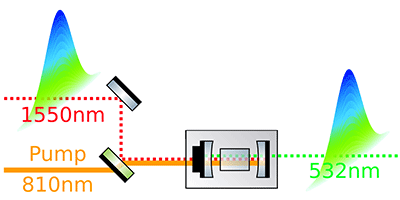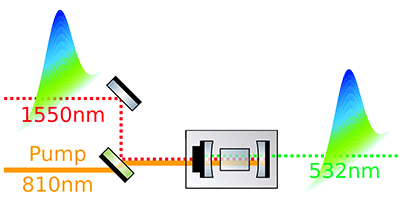Squeezed Photons Up-Converted to Higher Frequency
Nonlinear optics can boost the frequency of incoming light but, typically, only when that light is intense. Now, for the first time, a group has demonstrated the up-conversion of a faint source of photons in a quantum “squeezed” state. In Physical Review Letters, the authors report that the high-frequency output beam largely preserves the initial quantum correlations between photon pairs, making the technique of potential interest to quantum metrology and quantum communication.
Frequency up-conversion has the potential to improve spatial resolution in imaging and photolithography, both of which are limited by the wavelength of light. The most common technique is frequency doubling, in which two photons from the same source combine in a nonlinear crystal to produce a photon with twice the frequency. Quantum states can be up-converted in this way as well, as long as the source is bright. Many quantum applications, however, require less light to avoid scattering effects.
Roman Schnabel from the Albert Einstein Institute, Germany, and his colleagues have succeeded in quantum up-conversion of a faint source, which in this case consisted of squeezed vacuum states. The squeezing, here, refers to the reduced shot noise (or number fluctuations) in a beam of correlated pairs of infrared photons ( nanometers). This squeezed beam combines with a pump beam ( nanometers) in a mirror cavity containing a nonlinear crystal. Thanks to the high intensity of the pump, squeezed and pump photons interact to generate photons whose frequency is the sum of the combination (giving a visible wavelength of nanometers). The researchers verified that the output light was squeezed, although less than the input. This method of up-conversion could benefit quantum information networks that need to transform infrared light in optical fibers into visible wavelengths for storage. – Michael Schirber





